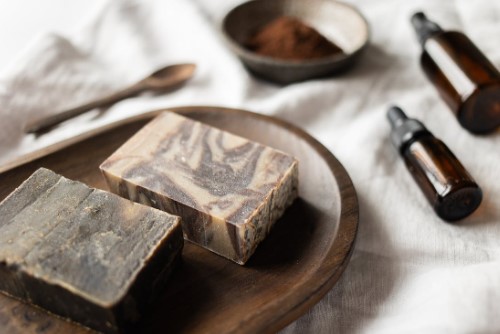Essential Oils and Fragrances
Essential oils are the building blocks of all fragrances. They are extracted from flower petals, grasses, seeds, leaves, roots, barks, fruits, mosses, and resins. Pure plant distillates have become increasingly popular in recent years, appearing in specialty stores and health food stores across the country. Because they require large quantities of raw material, they can be quite expensive due to their concentrated nature.
Keep in mind, that essential oils and fragrances can both provide pleasant scents, but there are some key differences between the two. Essential oils are usually considered to be more natural and often have therapeutic properties, however, fragrances can contain a mix of natural and synthetic ingredients and are used primarily for their scent.

An essential oil may not always capture the fragrance of a flower or fruit. There is no way to distill the lily of the valley or pear scent into an essential oil, for instance. Synthetic compounds have been created over the years to duplicate these scents, while the fragrance frontier has expanded to include compounds that smell like salty sea air. Modern perfumery relies on both natural and synthetic sources for fragrances – the newly developed aromatics add special and unusual notes, while essential oils round out, fix, and soften the compound.
Various methods are used to extract essential oils, including distillation, expression, solvent extraction, and enfleurage. Due to their individual properties, different plants require different extraction methods. As an example, citrus oils such as orange oil, lime oil, and bergamot oil are usually expressed (pressed) because the peel contains fragrant oils. Distillation, on the other hand, captures the essence of lavender. Perfumes are often created and manufactured using more concentrated fragrance materials than essential oils. By using volatile solvents, concretes are semi-solid, waxy substances derived from essential oils.
They have the closest odor to the original plant material. Concretes can be further concentrated by alcohol extraction to produce absolutes, the most concentrated perfumery materials. Many plants have essential oils that can be extracted through distillation. Chamomile oil can be extracted by submerging the flowers in boiling water, then capturing and cooling the steam that results. The oil separates from the steam after it condenses back into the water, and rests on the surface until it can be collected. This distillation process serves two purposes in perfumery.
Not only does it separate essential oils from plant material, but it concentrates and purifies them as well. In addition, sweet water is often sold from the water left behind with the plant material. Enfleurage is another common method for extracting essential oils. Cold-purified fats are used in this process to extract oils from a flower, a process that originated in ancient Egypt. Pomade is the resulting fatty product of enfleurage. The essential oils are extracted from the pomade using an alcohol solvent. Jasmine, rose, and violet oils can be produced using this method, but it is very expensive.
Composing a Perfume
The traditional perfume is a blend of essential oils extracted from spices, herbs, flowers, grasses, leaves, and woods, along with scent-prolonging fixatives. Modern perfumes are concentrated essences of fragrant materials including synthetic ingredients diluted in the smallest amount of high-grade alcohol. In deluxe fragrances, natural materials are used more often than synthetic ones. A fine fragrance must be filtered and matured in addition to the correct blend of scented materials. The product must also be safe to use on the skin.
When perfumers compose a fragrance, they have access to approximately 3,000 raw ingredients. To describe a perfume’s overall essence, perfumers use the terms top, middle, and base notes. French perfumer Septimus Piesse implemented a musical scale-based classification system for perfumes in the nineteenth century. He described perfumes as thematic, with each note carrying a common theme. The octaves of odor are analogous to those in musical compositions, according to Piesse.
A musical note is assigned to each odor in Piesse’s classification system, which is still used today. From its application to the skin to its drying down, a perfume’s final symphony of scent will contain all the right chords. In 1923, a man named W. A. Poucher improved Piesse’s work by publishing a classification method based on evaporation rate.
Based on an overall scale of 1 to 100, Poucher assigned top notes to the numbers 1 through 15 because they evaporate quickly. For example, mandarin is a 2, coriander is a 3, and nutmeg is an 11. Middle notes are rated from 16 to 69 and include ingredients such as marjoram (18), clove bud (22), and jonquil absolute and ylang-ylang (both of which are 24). Rose, tuberose, and jasmine absolute are all rated 43.
Base note fragrances, which last the longest, are rated from 70 to 100 and include galbanum and opopanax resins at 90, angelica at 94, and many valuable fixatives rated at 100. Those with the highest rating, meaning they last the longest and evaporate the slowest, include frankincense, benzoin, patchouli, sandalwood, oakmoss, tonka bean, and vetiver.
Poucher’s classification system was updated in 1991 and is still used by perfumers as a guideline when composing a fragrance. Historically, when a perfumer, who is called the “Nose” in the industry, set out to create a new fragrance, he or she began work at a structure called an organ. It consisted of a series of curved, stepped shelves, similar in shape to a church organ, lined with essential oils arranged by scent categories such as citrus or spice.

Additionally, a perfumer would have a large number of specialty bases, which are ready-to-use blends of synthetic and natural oils. There are fewer perfumers working in organs today. Perfumes are created in laboratories instead. The modern perfumer, who is still referred to as a nose in the industry, begins with the client’s product profile. A fragrance profile describes the client’s vision of a fragrance, its price parameters, as well as ideas for its style, packaging, and target audience. The perfume, packaging, and name should complement each other due to all the competition in the perfume industry.
Top notes (notes de tete) are the lightest and most fleeting part of a perfume, providing the first impression of the fragrance. The first few minutes of their appearance are short, but as the middle notes begin to appear, they blend in with them. The word “accord” derives from this. There is a harmonious blending of the notes. Top notes have a greater variety of fragrance sources than middle notes or base notes, just as floral fragrances have more ingredients. Floral geranium • chamomile gardenia • tagetes (marigold) Fruity peach • pear • plum apricot • raspberry • melon black currant bud Green galbanum • hyacinth lavender • rosemary • mint basil • clary sage Spices (sometimes appear as top notes) cinnamon • cardamom clove • coriander • pepper Citrus lemon • bergamot petitgrain • lime • pineapple neroli • mandarin tangerine Middle Hotee
The middle notes (notes de coeur) define a perfume’s character, classify its fragrance families, and can modify its base notes. The development of middle notes, also called heart notes, on the skin takes approximately ten minutes, and they can last for hours, harmonizing with the supporting base notes. Floral notes tend to dominate middle notes. carnation • cyclamen • daffodil • frangipani freesia • geranium • heliotrope • honey • honeysuckle iris ‘jasmine • jonquil • lilac • lily of the valley magnolia • mimosa • narcissus • orange blossom orchid • peony • rose • stephanotis • sweet pea tuberose • violet • water lily • white lily • ylang ylang
The top and middle notes are carried by the base notes (fund notes), which give the perfume its depth. A base note is sometimes described as a fixative because they prolong a fragrance’s evaporation rate, also called drydown. •ambergris • balsam • benzoin castoreum • cedarwood • civet • coumarin frankincense • labdanum • musk • myrrh oakmoss • patchouli • resins sandalwood • styrax • tonka bean vanilla • vanillin • vetiver







